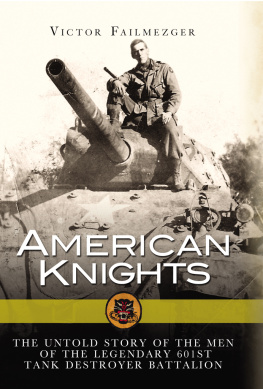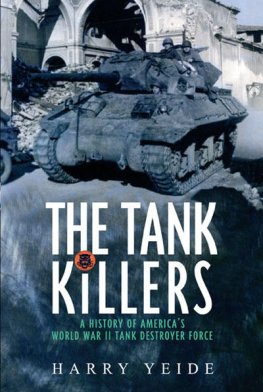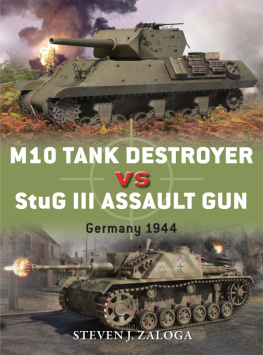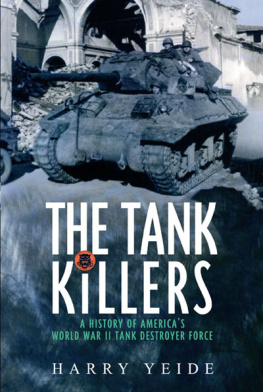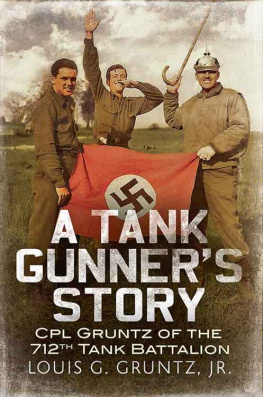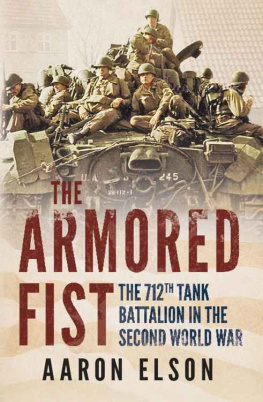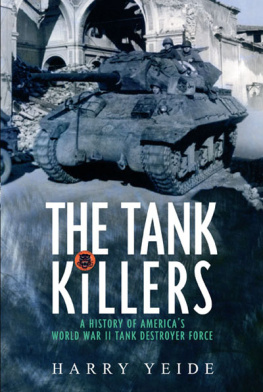This book is dedicated to the more than 1,800 officers and men who passed through the 601st during its short four-year history.
May the Tank Destroyer motto endure:
Seek, Strike, Destroy

This electronic edition published in 2015 by Bloomsbury Publishing Plc
First published in Great Britain in 2015 by Osprey Publishing,
PO Box 883, Oxford, OX1 9PL, UK
PO Box 3985, New York, NY 10185-3985, USA
E-mail:
Osprey Publishing, part of Bloomsbury Publishing Plc
Bloomsbury is a registered trademark of Bloomsbury Publishing Plc
2015 Victor Failmezger
All rights reserved
You may not copy, distribute, transmit, reproduce or otherwise make available this publication (or any part of it) in any form, or by any means (including without limitation electronic, digital, optical, mechanical, photocopying, printing, recording or otherwise), without the prior written permission of the publisher. Any person who does any unauthorised act in relation to this publication may be liable to criminal prosecution and civil claims for damages.
Every attempt has been made by the Publisher to secure the appropriate permissions for material reproduced in this book. If there has been any oversight we will be happy to rectify the situation and written submission should be made to the Publishers.
A CIP catalog record for this book is available from the British Library.
Victor Failmezger has asserted his right under the Copyright, Designs and Patents Act, 1988, to be identified as the Author of this Work.
ISBN: 978-1-4728-0935-3
ePub ISBN: 978-1-4728-0937-7
PDF ISBN: 978-1-4728-0936-0
Cartography by Peter Bull Map Studio
Typeset in Garamond and Baskerville
Front cover and title page: Lieutenant Welch of the 601st mounted on an M-10 tank destroyer at Calvi Risorta, December 1943. (Authors collection)
Editors note on the photographs
To illustrate this personal story of the men of the 601st, the author has eschewed official, staged images and provided instead photographs taken by the troops, often in adverse conditions or combat. The size and quality of the images is balanced therefore by their authenticity.
Editors note on the quoted material
Much of the quoted material is the diaries and letters of soldiers and as such contains idiosyncrasies of spelling and language. These have been left intact wherever possible in order to present the true voices of the men. Additionally, the reader will note that US military style of the time gives dates in the reverse of the usual order of month followed by day, and these, as well as the unaccented or varied spellings of European place names, have been retained in the quotes.
Osprey Publishing supports the Woodland Trust, the UKs leading woodland conservation charity. Between 2014 and 2018 our donations will be spent on their Centenary Woods project in the UK.
www.ospreypublishing.com
C ONTENTS
M APS

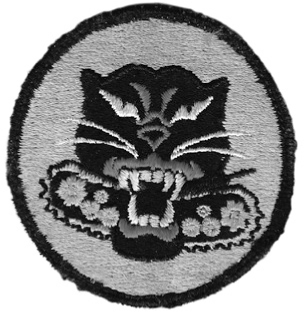
A CKNOWLEDGMENTS
When I began transcribing the more than 150 letters my uncle wrote during World War II, I had no idea it would turn into a book, let alone two books. I got to know my uncle, Thomas Peter (Tommy) Welch, during my time as an undergraduate at Southern Methodist University (SMU 196569). Because he didnt talk about the war, I remained curious about his experiences. I knew of course Welch was a war hero as one night he showed me his medals without explanation. Also I knew the war was responsible for his having moved to Texas. In 1998 I finished a transcription of the letters from 1942 and it was apparent there was a great story here.
After my mother died, my sister went through all of her papers and provided even more raw material. Cold winters and early retirement motivated me to finish the transcripts. As I did, I went through Welchs US Army records as saved by my grandmother and started to match dull, and some not so dull, military records with events mentioned in the letters. It became obvious to me that I could probably track my uncles movements and actions during the war in significant detail and that it would be worth doing. The result was the 2012 book An American Knight, a Tank Destroyer Story. Osprey Publishing was intrigued with the book and invited me to expand the work and tell more of the 601st story. In the process, I was amazed how much more there was to learn.
As with the first book, since the principals are mostly gone now, I wanted to let their words and words of their contemporaries speak for them. Where possible I have traveled to the exact locations where events took place, both in Europe and the United States. Italy is a country I know well, having spent ten years of my life there. Special thanks here to my wife, Patricia, not only for editing help but also for helping navigate modern Italian roads and highways while looking for telltale remains of World War II. In 2011, we made a five-day dash across France following, as she put it, the Tommy Trail. We even attacked the Siegfried Line, stopping for a beer and a glass of wine along the way in what would have been the middle of it.
In Germany, we visited our friend and former next-door neighbor, Dr Rolf Wirtgen, curator for the German Armed Forces Weapons Collection (the Wehrtechnische Studiensammlung at the Bundesamt fr Wehrtechnik und Beschaffung) at Koblenz. Rolf gave me an exhaustive tour of the collection and made sure I had correct information on the German weapons described here.
Thanks also to my first line reviewer and longtime friend, Chief Petty Officer Peter R. Knight, Royal Navy (Retired). Pete and I were stationed together in Castel Volturno, outside Naples (45 years ago) and he still lives in the area. Of special note, Petes dad, Ronald Orton Knight, served with the Royal Air Force (RAF), attached to the British Eighth Army. He too was a World War II hero and had been in many of the same places in North Africa and Italy where the 601st Tank Destroyer Battalion fought.
Thanks to Mr Howard Klein, formerly a critic for the New York Times (who acted as my amanuensis and kept me from burying the lead) and Mr Malcolm Barr, a veteran of The Associated Press. Howard served in the USAF and Malcolm the RAF. They read early drafts of the book and made significant comments on the manuscript and earned my gratitude.
As a retired naval officer, I also found I had to be careful about unfamiliar Army expressions and give thanks to two retired US Army reviewers, LTC Tim Stoy and COL Lars Larson. Both helped immensely. Tim is a historian for both the 3rd Infantry Division and the 15th Infantry Regiment. Lars uncle was one of Welchs sergeants and he contributed more than 40 pages of letters and many photographs.
A special thanks to CPT Monika Stoy, US Army (Retired) and Tims wife. Monika is a one-lady whirlwind in recognizing the towns and villages the 3rd Infantry Division liberated in France. She also organized seminars on Operation Dragoon and the Colmar Pocket. At one of the seminars, I met Mr Joseph Borriello. Joe was a corporal and later first sergeant with the 10th Engineer Battalion. He was assigned to the 3rd Infantry Division and followed the same route as the battalion. Many of his memoirs are included in this work and I enjoyed talking with this very active 92-year-old.

